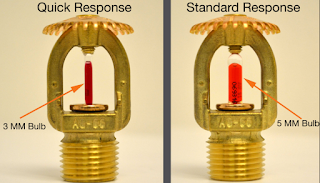Standard vs quick response sprinkler heads is an on going debate. Let's see which one is better for the occasion and how they work.
Each fire sprinkler
system has ability to control fire based on six different characteristics.
These main characteristics include temperature rating, orifice size, thermal
sensitivity, special service conditions, water distribution and installation
orientation. In addition to these, there are two different types of sprinkler
heads that you are able to choose from. Different types of sprinklers are
especially designed for different types of buildings, so you have to know which
type of fire sprinkler head your building requires.
The fire sprinkler heads
are divided into two categories: standard fire sprinkler heads and quick
response fire sprinkler heads. Both of the fire sprinkler head types are chosen
for protecting a property effectively. The question is how to choose between
these two? How to pick the fire sprinkler heads suitable for your place? First,
take a closer look the main differences between standard and quick response
sprinkler heads, how are they primarily used and then you will know how to make
the right decision.
Standard Fire Sprinkler Heads
The standard sprinkler
heads are designed to pre-wet the materials around the fire. This helps in
removing the fuel source. Soaking the surrounding area by the standard sprinkle
heads slows the fire and it buys critical time until the fire department comes
and extinguishes the fire. Slowing the fire is also a good prevention for the
fire spreading around in other areas of the building. These types of sprinkler
heads are individually activated which means that only sprinkle heads directly
above the active fire will activate.
Quick Response Fire Sprinkler Heads
The quick response
fire sprinkler heads are primarily used and applied for light hazardous
situation, like in schools, health care facilities, assisted living facilities
and office buildings, where there is a quick response needed. These types of
fire sprinkler heads have similar fire control application to the standard
ones, but they’re designed with a bit different focus. Quick response sprinkler
heads are able to discharge water higher up on the ceiling in order to stop the
fire from climbing up the walls Also, they can keep and maintain lower ceiling
temperatures which cools the ceiling, reduces the possibility of flashovers and
provides bigger odds of survival and evacuation of the people in the building.
The Differences between Standard and Quick Response Fire Sprinkler Heads
The main and biggest
difference between these two types of fire sprinkler heads is their activation
temperature. As the name applies, quick response fire sprinkler heads activate
a bit more quickly than the others. Another important difference, which by the
way is physical, is the bulb size. The smaller the bulb is, the quicker the
response time. Standard sprinkler heads have a 5 mm glass bulb filled with
glycerin-based liquid, while quick response sprinkler heads are made with 3 mm glass
bulb and thus, they are quicker to respond to the headed room. This fact
implies that it’s better to install quick response fire sprinkler heads, but
you should note that there are some other things to be considered. For example:
the ceiling height, the ambient temperature throughout the whole year and the
size of the area you want to protect. No matter what type you choose, we are
here to install it for you and maintain the system whenever needed.

